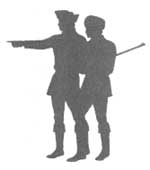|
NATIONAL PARK SERVICE
The Lewis and Clark Trail A Proposal for Development |

|
OUTDOOR RECREATION DEMAND ALONG THE LEWIS AND CLARK TRAIL
Sufficient statistical data are not yet available to codify and quantify specific demands for various types of outdoor recreation activities and facilities along the Lewis and Clark Trail or for any specific section thereof. Nevertheless, the scenic, wildlife, and water recreation resources that exist across this section of America, combined and tied together by their relationship to the historic Lewis and Clark Expedition, present a supply of potential recreation opportunity of major proportions. At the same time, these resources also have the potential to help divert the overwhelming demand for outdoor recreation outlets that is being experienced elsewhere.
The demand for recreation facilities has been steadily increasing and is expected to continue in the foreseeable future. An indication of this soaring demand is evidenced by the number of visitors at State recreation areas within the ten States encompassed by the Lewis and Clark Trail. On the average, attendance quadrupled in the ten-State area from 1954 to 1962. It can be assumed that recreation facilities along the Trail carried a proportionate share of the increase. Because of the high recreation value of the Missouri and Columbia Rivers which comprise the major segment of the Expedition route, the pressures from outdoor enthusiasts will continue to spiral.
The Interstate Highway System, now nearly half completed, will increase the demand for recreation facilities along the Trail. It has been estimated that this highway system, even though it will comprise only one percent of all major highways in the United States, will carry 21 percent of all traffic. Five of the principal east-west Interstate routes and four of the main north-south routes cross or parallel sections of the Lewis and Clark Trail. Two additional Interstate routes also make connections with the Trail. Unless definite steps are taken to inform the Interstate System travelers of the attractions and recreation facilities available along the route, however, these Interstate highways may very well have the effect of funneling tourists and recreationists right past the recreation opportunities.

Only in recent years have some areas traversed by Lewis and Clark become major recreation attractions. Much of the Missouri River is a case in point. In addition to picnicking and camping along the Missouri, boating, water skiing, and sport fishing have become important recreation activities. The completion of numerous impoundments by the Bureau of Reclamation in the Department of the Interior and the Corps of Engineers in the Department of the Army has created extensive bodies of water that are ideal for these recreation activities. The dams have also stabilized the channels of the river, permitting greater use of the shorelines. Similar engineering works have also enhanced the recreation use of the Columbia River.
Interest has been renewed in seeing and visiting historic and archeologic sites. Visitations to Fort Clatsop in Oregon numbered 72,000 in 1964, and thousands more visited other historic sites and monuments along the Trail. While most of our historic locales are already identified, their development ranges from uninscribed stone markers on isolated side roads to the modern interpretative installations of the National Park Service.
The vacationing public's time and interest is at a premium. An attempt to develop and stimulate interest in all historical sites along the Trail would be a mistake. A great deal can be done, however, to assist the public to locate and visit the outstanding historic sites and to use the major recreation resources along the Trail.
 |
|
Horseback riding and boating represent important recreation activities along much of the Lewis and Clark trail. |
It therefore seems reasonable to assume that demand along the Trail will increase significantly in the years to come. In addition, the developments proposed for the Trail, when completed, will generate demand for still more facilities.
Recreationists who will use the facilities paralleling the Trail fall into three groups. Those primarily interested in the Trail because of its historic significance in relation to the Lewis and Clark Expedition are one. This group will be nationwide in scope and the demand generated will largely depend on how well the actual historic values are identified, preserved, interpreted, and promoted.


The second group will consist of those interested in the recreation facilities along the Trail, as related to their vacation travel needs between the Pacific Northwest and the eastern and midwestern sections of the country. This group tends to be regional in scope and its demands are closely tied to travel routes between destination points. If areas of more than local or State significance are developed along the Trail, then such areas might possibly become destination points, or at least serve to deflect this group from the usual routes of travel.
The third group will be made up of those local or nearby residents along the route whose recreation demands are not being met elsewhere. This group may well comprise the majority of recreation users at many areas, primarily because of the distance that people are willing to travel for recreation. On a vacation trip, over half of the people seek recreation one or two day's travel from home. For weekend and day trips they will travel only a few hours. The Outdoor Recreation Resources Review Commission reported that 23 percent of people taking vacation trips will travel between 100 and 250 miles. Thus, heaviest recreation use can be expected from residents living within 250 miles of the Trail.
| <<< Previous | <<< Contents>>> | Next >>> |
lecl/proposal-for-development/demand.htm
Last Updated: 11-Jun-2012